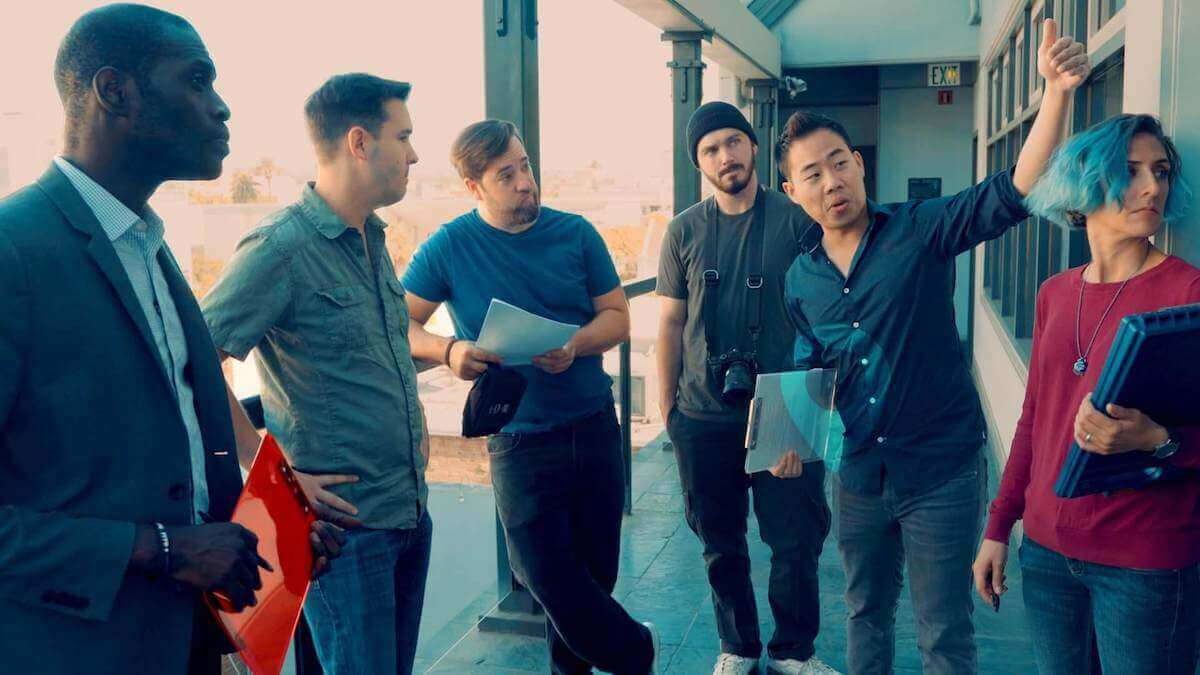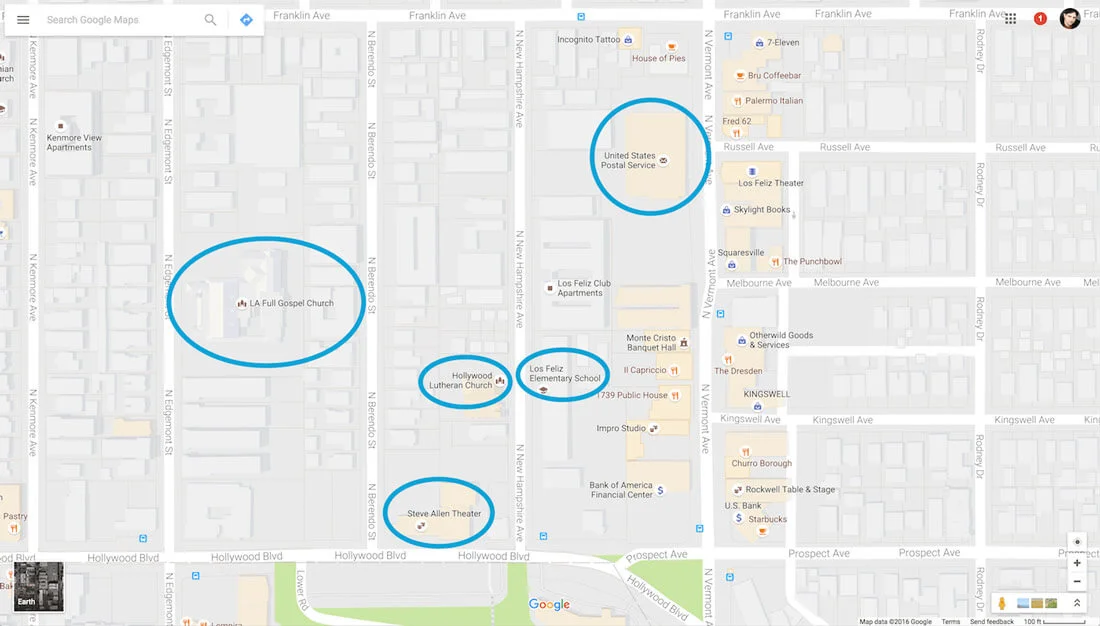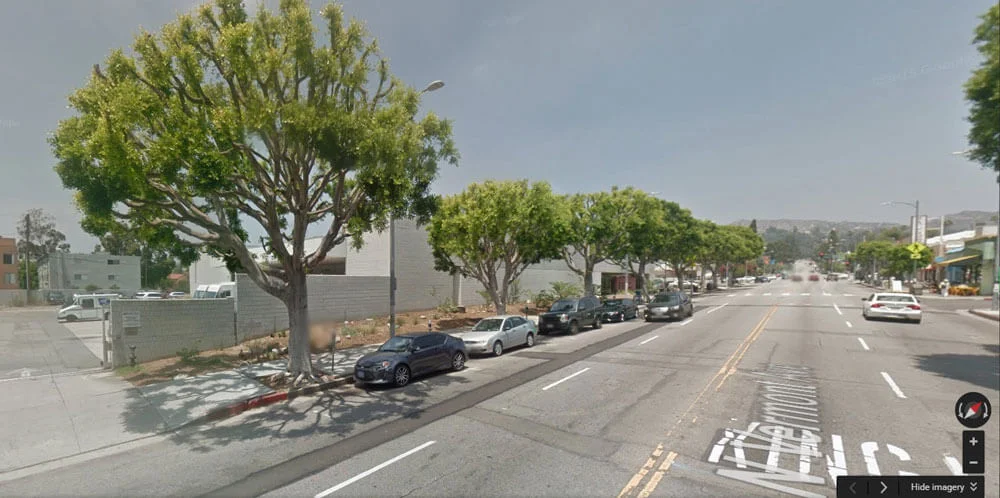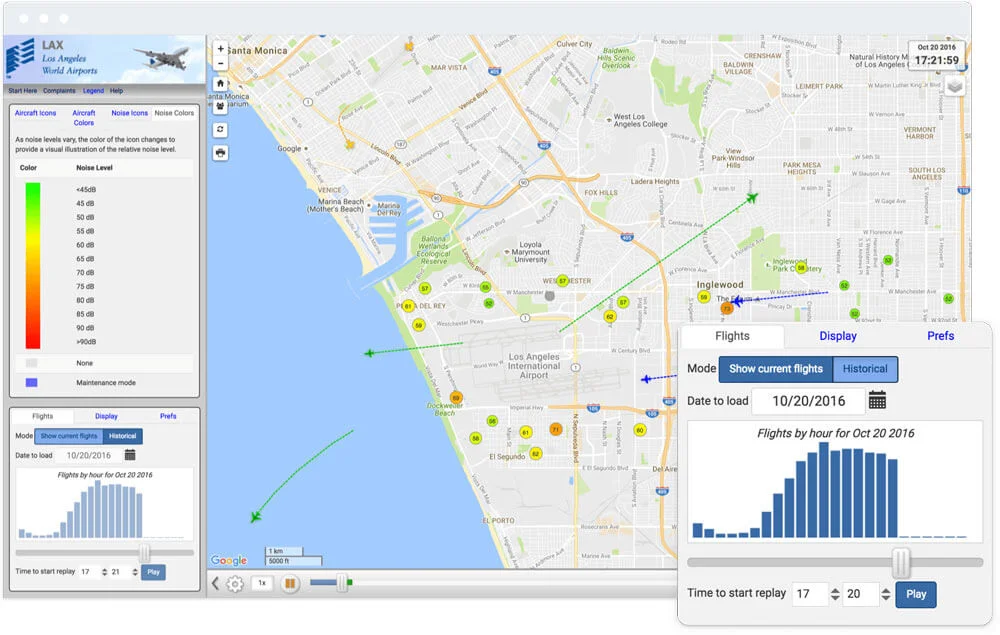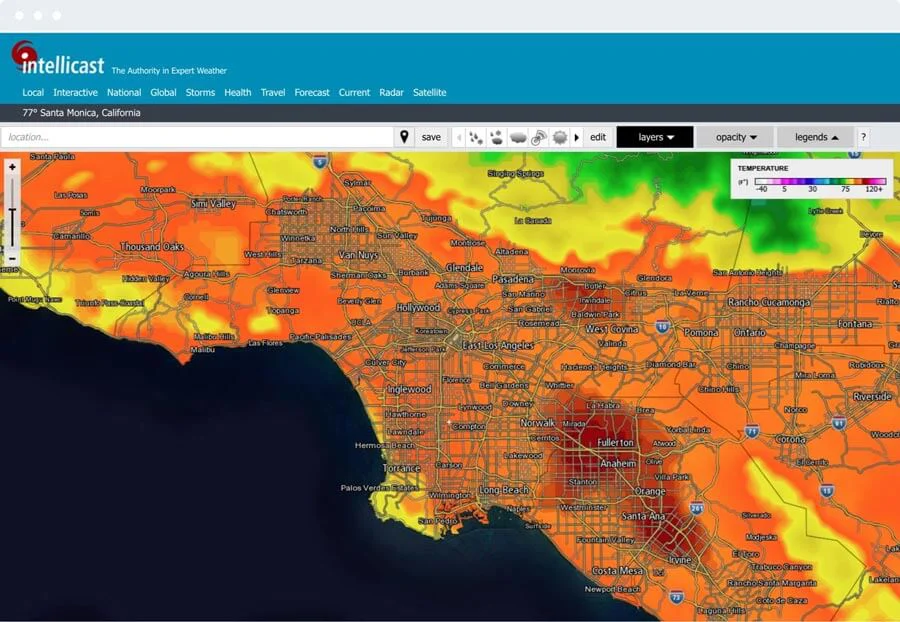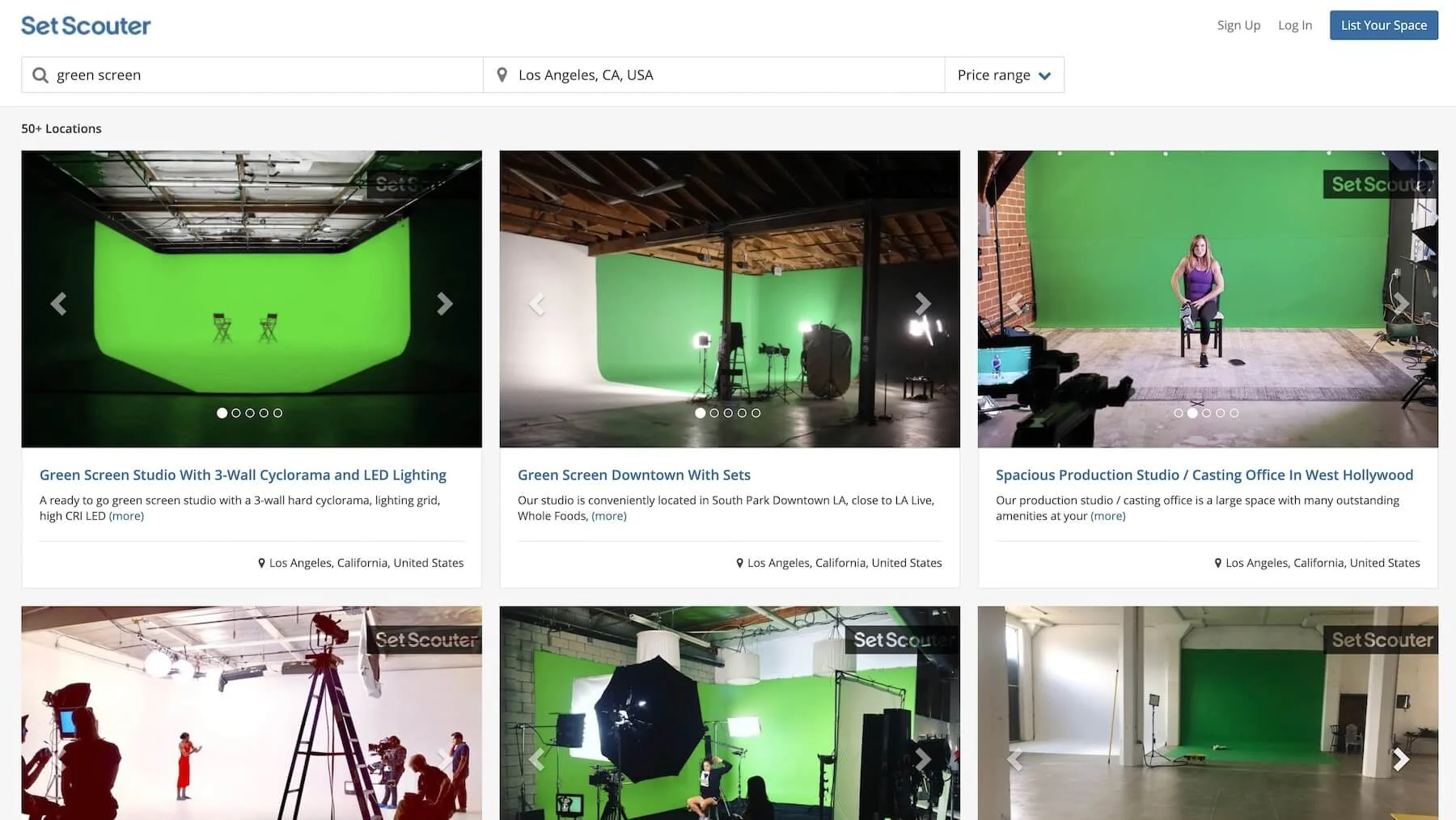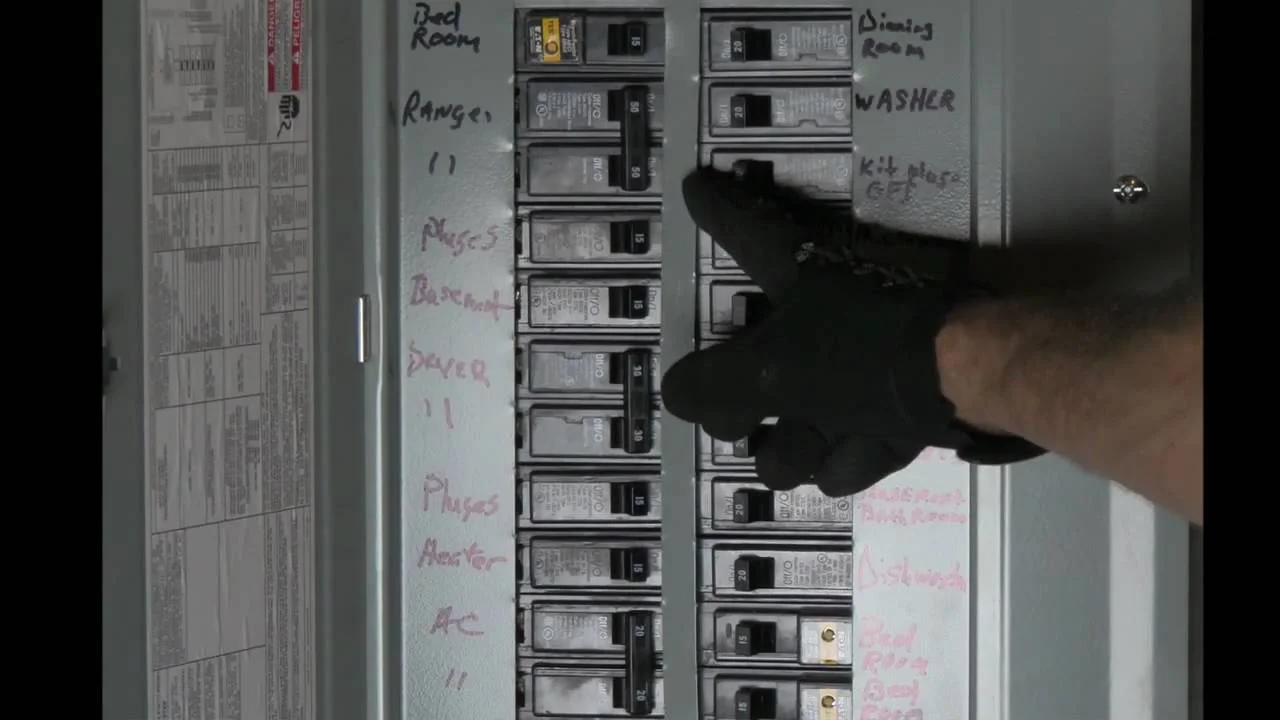T
he film location scout has found the ‘perfect’ place for next week’s shoot. Sure it may fit the scene, but what if they’ve overlooked some important considerations that could potentially ruin a shoot day? It’s your responsibility to make sure that doesn’t happen.
We’ve put together in-depth film location scout checklist to help you identify whether a shooting location fits a production’s many technical and logistic needs.
FILM LOCATION SCOUTING checklist
Before your next location scout
Below, I will outline everything you need for a thorough location tech scout for film.
By the end of this post, and with our location scouting checklist sheet handy, you’ll have everything you need to determine the viability of any shooting location.
location scouting for film
1. It all starts with the storyline
The most important element to consider when tech scouting for a shooting location is the story.
First and foremost, see if the site under consideration matches the scene and advances the film’s story. Even great location scouts might think of the location as just a setting for the action, and lose context.
A location scout is an opportunity to not just support the story, but to advance it. Make sure your location scout and all relevant department heads have read the script prior to tech scouting the shooting location.
For example, should you sprinkle this sci-fi dystopia with pristine, modern architecture? Does it fit the vision the director established? Does it clash with any established visual elements for the scene?
Don’t get so mired in securing a site when location scouting that you forget to consider story.
So, how can you tell that the location scout has considered the story?
Check for anachronisms. Does the setting fit the time period and story location? Are you shooting a Victorian period drama in a park full of electric lights?
Consider Sight
2. Visualize the shots
Imagine what the camera will see when tech scouting locations.
There are universal visual questions you must ask when location scouting:
- What will we see in the frame?
- How wide are you shooting?
- Are you just shooting into a corner, or will you need complete coverage?
- Are the important establishing elements all visible in a single frame?
- Can you create a clear frame with appropriate background objects?
- How much effort will it take to transform the space into what you need?
- Do the shots contain commercially owned properties that need clearance?
Here's DP Roger Deakins on how he has approached location scouting on some of his most iconic movies.
Roger Deakins & Location Scouting • Subscribe on YouTube
You can usually make a space work in a pinch, but sometimes it’s just not worth the effort.
Is this the best use of time, money, and manpower to transform a so-so location into the perfect location?
If not, don’t be afraid to move on.
Pro tip
To understand what the film will look like, first check the breakdowns, shot lists and storyboards provided by the director and the rest of the production team.
SHOOTING INDOORS. ENOUGH SPACE?
First, check if your indoor space is big enough. Can you get the camera, lights, boom, and people, far enough away from the actors to realize the frame for the shot?
If you are shooting a night scene indoors, during the day, select a room without windows if possible. Otherwise, plan to give your gaffer extra time and spend extra money blacking out the windows.
SHOOTING OUTDOORS? THINK ABOUT THE SUN
All good location scouts know the sun rises in the East and sets in the West! Your location is affected by sunlight differently over the course of the day. If you examine the perfect spot in the afternoon, don’t forget to consider what it looks like a few hours later or earlier in the day.
VFX CAN HELP
I’ve filmed medieval epics with wonderful castle vistas, but the only ones available to our location scouts were full of power lines. Our visual effects artists were able to save the day by removing the offending lines.
It shouldn’t be your first plan, but in a pinch, VFX can work wonders.
Here’s a before and after example from one of my films:

When the location scout selected this castle, there was consideration for whether post-production would be able to transform it into the final film.
Check with your VFX team to make sure they can work with any visual limitations of the space. Just bear in mind when location scouting that every power line or billboard removed will eat into your post-production budget. It adds up quickly.
Free downloadable bonus
Download FREE Location Tech Scouting Checklist
Are you getting close to your next location tech scout? We've put together a checklist to help you identify the key elements to look out for before you actually lock down the location. Download our FREE, printable checklist PDF today!
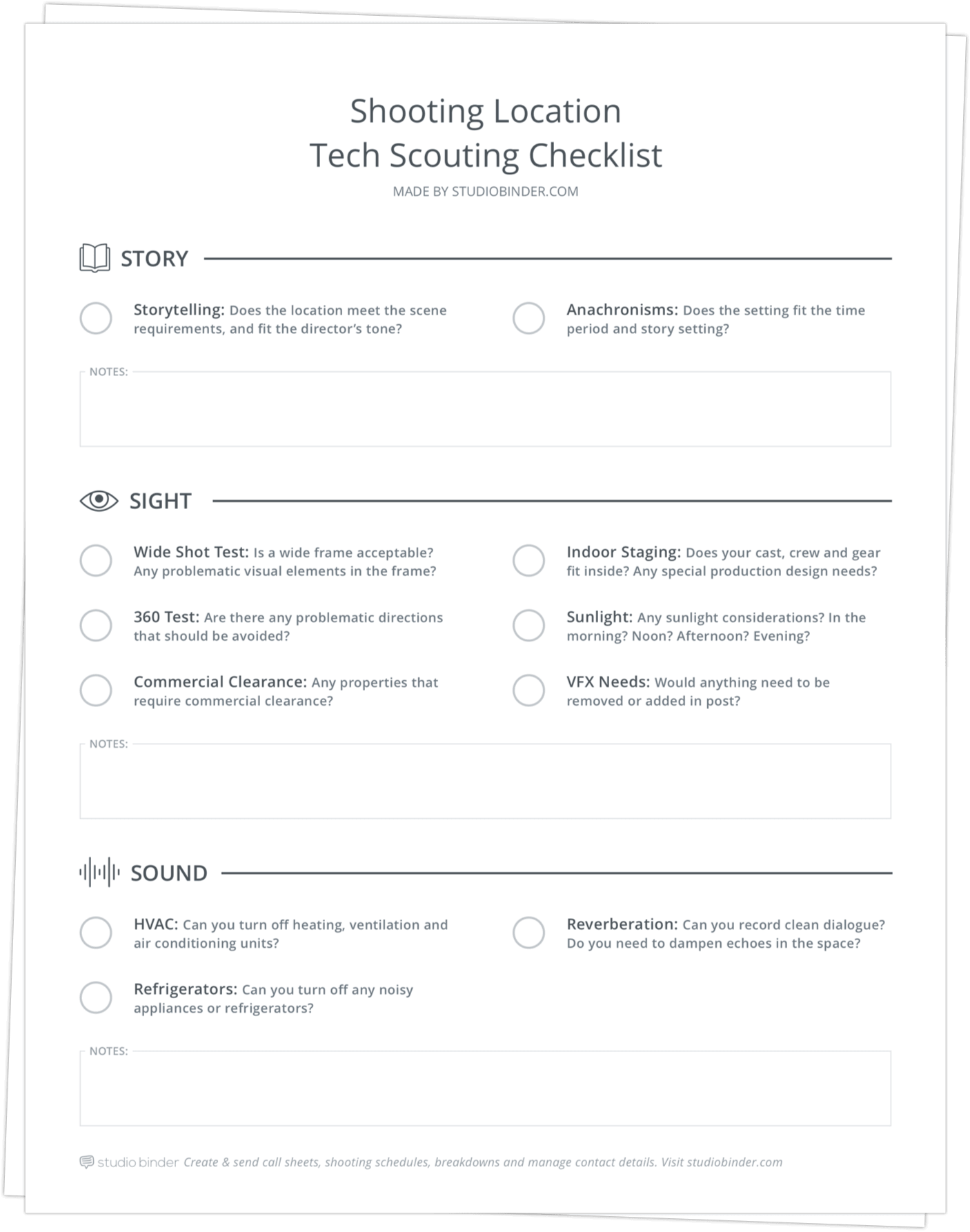
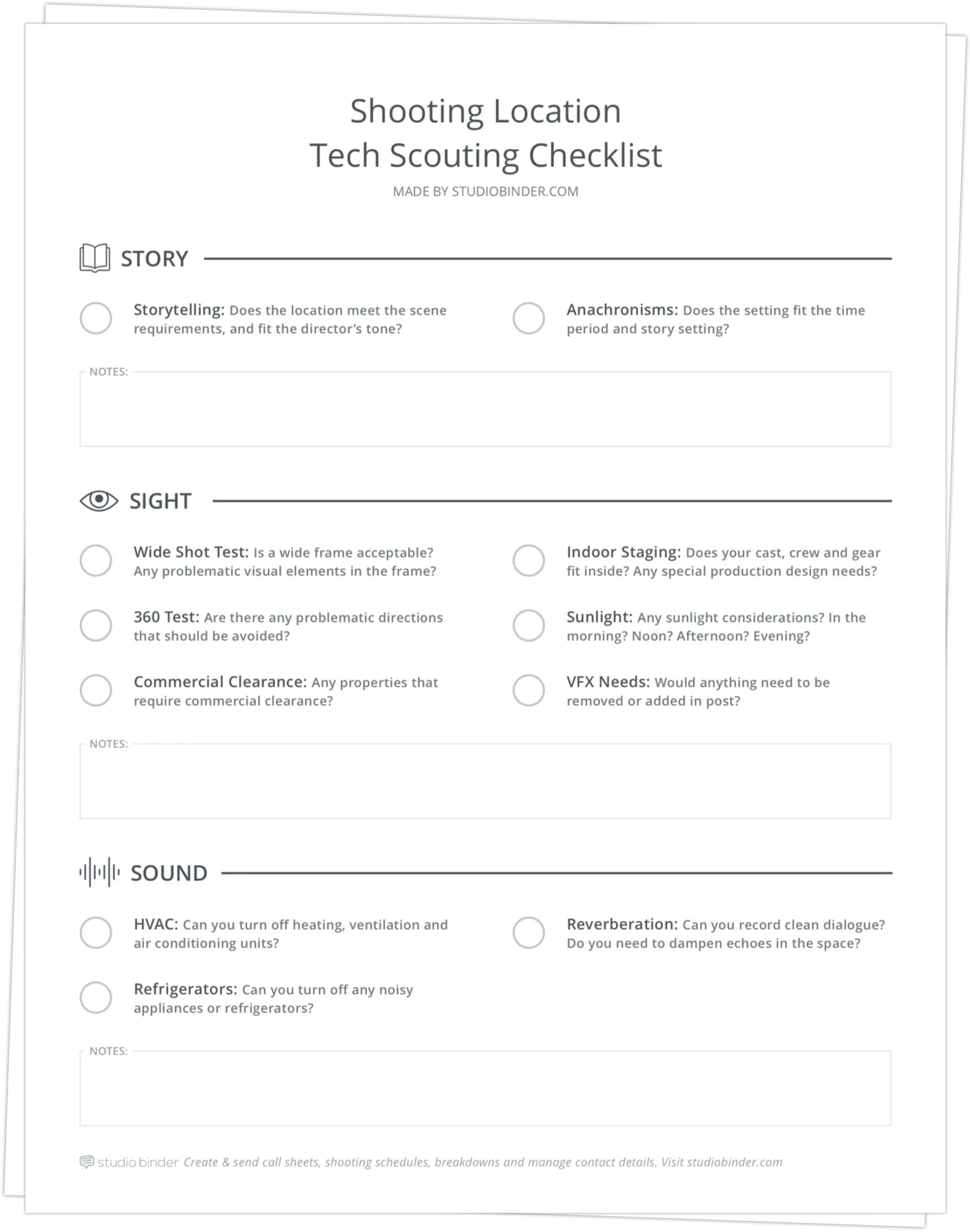


sound is 50% of your project
3. Consider the sound
Location scouting for sound is often overlooked, but don’t forget that it ultimately accounts for 50% of your project.
Being able to record clean dialogue is one of the most important requirements for a smooth shoot. The last thing you want to hear every other take is “Hold for sound!” just because you missed something important when tech scouting the location.
When you’re scouting a location, listen carefully for any noises that could become problematic.
We’ll cover some of the most common offenders below.
REFRIGERATORS AND HVAC
You can sometimes do some cleanup of your sound in post-production. But it will never be as good as getting clean sound during production.
White noise appliances like refrigerators and HVAC (Heating, Ventilation and Air Conditioning) are the top killers of clean sound. Make them a priority consideration when location scouting.
I have often been let down by promises from location scouts that a space was cleared for perfect sound. In one case, a humming refrigerator could only be shut off by flipping circuit breakers...which by-the-way ended up also cutting the main power to the entire space.
We’ll review electrical considerations further in this post, but when it comes to HVAC and refrigerators, here are some things you should consider when you’re tech scouting your location:
- Check all sources of noise and how to turn them off.
- Make sure you have the owner’s permission to do so.
- Make sure shutting sound sources down does not affect other systems.
- Don’t take anyone’s word that you’ll be able to do it on the day. Test it out before shoot day.
- Air conditioning systems do not always turn on and off instantly. Flip switches and time how long it takes to go silent.
REVERBERATION
Adding reverberation in post is a piece of cake.
Taking it away, not so much.
If you shoot in a large or reverberant room, check with your sound department to see if they need extra time to dampen the space.
If you can’t easily resolve it, consider shooting closeup coverage in a matching smaller space.
I was once hired to do sound on a shoot in a locker room with eight shirtless characters talking in all different parts of the locker room, so it was impossible to use lav mics.
On top of that, we shot very little closeup coverage, so shotgun mics couldn’t get close enough to compensate. We had to scramble last minute to dampen the space with as much padding as we could find. It helped, but we could have solved the problem more comfortably if there was advanced planning.
Related Posts
Consider the Environment
4. Mind your surroundings
Recently, I tech scouted a location. It was a lazy Sunday afternoon, and everything seemed great.
However, when we arrived to shoot the following Monday, the situation was completely different. All we could hear were joyful screams of schoolchildren playing in the schoolyard next door! Not great for shooting clean dialogue.
The whole thing could have been sidestepped if we had minded our surroundings more carefully during the tech scout. In other words, don’t forget to take shoot day and time into consideration for locations as sound conditions change frequently.
Mind your surroundings when location scouting
Nothing beats walking around the neighborhood during the days and times you plan to shoot, but Google Maps can also be your best friend when planning a tech scout.
Here’s how to use it on a location scout for film:
First, zoom in on the map view of the neighborhood and check out all of the surrounding buildings.
Are there any busy roads, schools, airports, factories, playgrounds, gas stations, post offices, warehouses, train stations, train tracks, or any other spaces that might have human or vehicle traffic patterns that could affect the shoot?
Identify them:
Use Google Maps when location scouting
Check it again on Street View. Digitally “walk” around the block and look for anything potentially problematic. Note them and things to scope out when you’re physically tech scouting the location.
Street view in Google Maps
I once shot near a river. We had our tech scout on a day when no shipping boats were passing through. But on the shoot day, 10 minutes wouldn’t go by without a shipping horn blowing.
AIR TRAFFIC
Everywhere on Earth is affected by flight-pattern noise.
If your local airport has a tool for tracking flight patterns, take a look and see if that might be a serious concern for you. LAX has this nifty tool.
Look at air traffic when scouting
Scouting locations for airplane noise can be tricky because flight patterns can vary by the day or hour. Extra traffic can result in flight-pattern changes for an airport.
The LAX tool lets you look at historical data. Check for similar tools in your region.
PRO TIP
When examining urban shooting locations, don’t forget to consider underground subway noise.
WHERE TO STAGE GEAR AND DEPARTMENTS
When you’re excited about a location that works for story, it’s easy to forget about all the gear that needs to go somewhere. It takes a lot of stuff to make a film!
You’ll need to sort out where you’re going to put everything before you get to set. Otherwise, you waste precious shooting time solving space issues that could have been solved earlier.
On your location scouts, make sure you have a place for these things:
Craft services, catering/dining tables, parking for crew/talent/VIPs, hair/make-up, wardrobe staging/changing rooms, camera staging, art department trucks/staging, grip/electric trucks/staging, generators, production office, talent staging, sound staging.
Pay attention if there is any special equipment or elements in the production such as stunt equipment, cranes/jibs, armory, pyrotechnics, or live animals.
Don’t want to forget anything? Download this location scouting checklist and take it with you to when tech scouting.
Related Posts
SECTION OFF A DEDICATED SPACE FOR TALENT
You cannot just slam actors in with the rest of the crew.
They need their own private space to focus. If actors are distracted, they can’t memorize lines or get to the emotional place needed for their work.
And the film will suffer.
Good location scouts know that they are contractually obligated to give SAG-AFTRA performers personal space and a bathroom separate from crew. It’s a good idea, even for non-union actors.
So, make sure you have an eye on where you’re putting each actor. Will they have their own rooms? Will you be parking a ‘Star Wagon’ (actor trailer) nearby? Where? Where will you stage background talent?
Your shooting location needs room for all of these things.
DON’T FORGE
While location scouting, be sure there is enough parking for cast, crew, trailers, and production vehicles. This may or may not be something that your film location scouts will consider by default.
Consider how many vehicles to expect and make sure to follow local laws and permits. FilmLA rarely allows street parking in residential neighborhoods for a large crew.
Read more about parking prep: 7 Pro Tips for Planning Crew Parking.
Free downloadable bonus
Download FREE Location Tech Scouting Checklist
Are you getting close to your next location tech scout? We've put together a checklist to help you identify the key elements to look out for before you actually lock down the location. Download our FREE, printable checklist PDF today!




Consider weather
5. Location scout the weather
Despite your magical organizing powers, weather is outside of your control. But slight changes in geography can have a big impact. Consider avoiding valley hotspots or precipitation pockets on the sides of mountains when possible.
The Los Angeles area is known for microclimate variation. Locations a few miles apart may vary in temperature by 30 degrees or more.
Look at the clime when location scouting
Even if your shooting location is indoors, take weather into account. Consider the impact of rain and wind on sound or available light.
A beautiful, glass-covered space can turn into a rain amplifier and ruin your sound for the day if a storm hits. Wind blowing trees outside can make for a distracting background.
FILMING LOCATION WEBSITES OR APPS
A filming location app may help you and your location manager find shooting locations to fit your story.
Services like SetScouter (which acquired Wrapal in 2019), enables users to search vetted shooting locations, or list them. Each location provides photos, and you can narrow down prospects by keywords, rooms, size, and pricing.
Then the pricing is negotiated and ground rules are communicated within SetScouter. And, just like AirBnb, giving and receiving reviews can boost your reputation for future transactions.
Searching for sound stages using Setscouter
CONSIDER ELECTRICITY
6. Stay on top of power
Here’s an all-too-familiar situation: Your film location scout sends you a message. “Look at this beautiful ballroom. Perfect for the elegant dance scene. Outlets everywhere!” Great! You check power concerns right off the location tech scouting checklist.
….But on the day of the shoot, the breakers flip every time you turn the lights on. This is yet another reason why tech scouting is so important.
Stay on top of power when tech scouting
Checking for outlets are not enough. Here are some power considerations to check off:
- Check for Outlets. Identify how many outlets are available, and where.
- Check the Breaker Box. Make sure there is enough power to run lights, camera, hair, makeup, sound, craft services, and the local production office.
- Label outlets and breakers. You don’t want to scramble to find out which breaker controls which outlet in the middle of a shoot day.
- Involve the Electrical Department. Be clear with the electrical department about production needs. Your electrical department will want to know that outlets are properly grounded. No surprises on the shoot day. I’ve even seen great location scouts visit potential locations with an outlet tester to make sure wiring is properly done.
- Secure Access to the Breaker Box for the Shoot. Be sure your location manager has access to the breakers. Nothing kills a day faster than having to call location owners to figure out how to get into a locked breaker room. Remember, you may also need to reach breakers to shut off HVAC or other sounds.
- Use Separate Circuits for Some Departments. Find out if any other departments on your shoot have special electrical needs. The most common power snafu I’ve encountered happens when your hair and makeup crew are using the same breaker as your lights.
Film Location Scouting
7. Confirm access to facilities
After a great start, you call your first, “take five!”
Forty cast and crew all head toward the one single-occupancy bathroom on set. Five turns into fifty. While everyone waits in line, you realize you’ll be spending the rest of the shoot coordinating everyone’s bathroom breaks.
I like to secure shooting locations that offer at least one bathroom for every fifteen people.
It is also useful to ensure you have access to water, gas, and other plumbing shutoffs in case of an emergency.
Contracts
8. Securing filming location contracts
Your film location scout most likely uses a release to secure your locations in advance.
Make sure these contracts are signed, explicitly arranged, and include flexible options for extending time on location whenever possible. For example, if you’ve shot three days and the director really wants to pick up a fourth day, the shooting location owner has a lot of power to ask for anything they want.
Unless you’ve already stipulated in your contract how much additional days cost. Make sure your film location scout has prepared the agreement and the owner for the unexpected.
Also ensure that your insurance coverage will include the shoot location. A film-savvy location owner will usually ask for insurance paperwork to prove their space will be protected.
NEED A LOCATION RELEASE AGREEMENT, DOWNLOAD ONE FOR FREE.
Up Next
Grab your location scout checklist
A good location scout for film will make your job easy and provide you with multiple options for each shooting location.
It’s your job to review the locations, scope it out in person, and decide the best location for your budget and production needs.
Double-check whether your shooting location fulfills all the most important logistic requirements by downloading a free Location Tech Scouting Checklist below.
Whether you’re a location scout or a 1st AD tech scouting, the checklist is a handy printout to help you think out all the logistics of a location.
Just download and print out the checklist below, and you’ll be ahead of the game!
Free: Location Scout Checklist
Film Tech Scouting Checklist
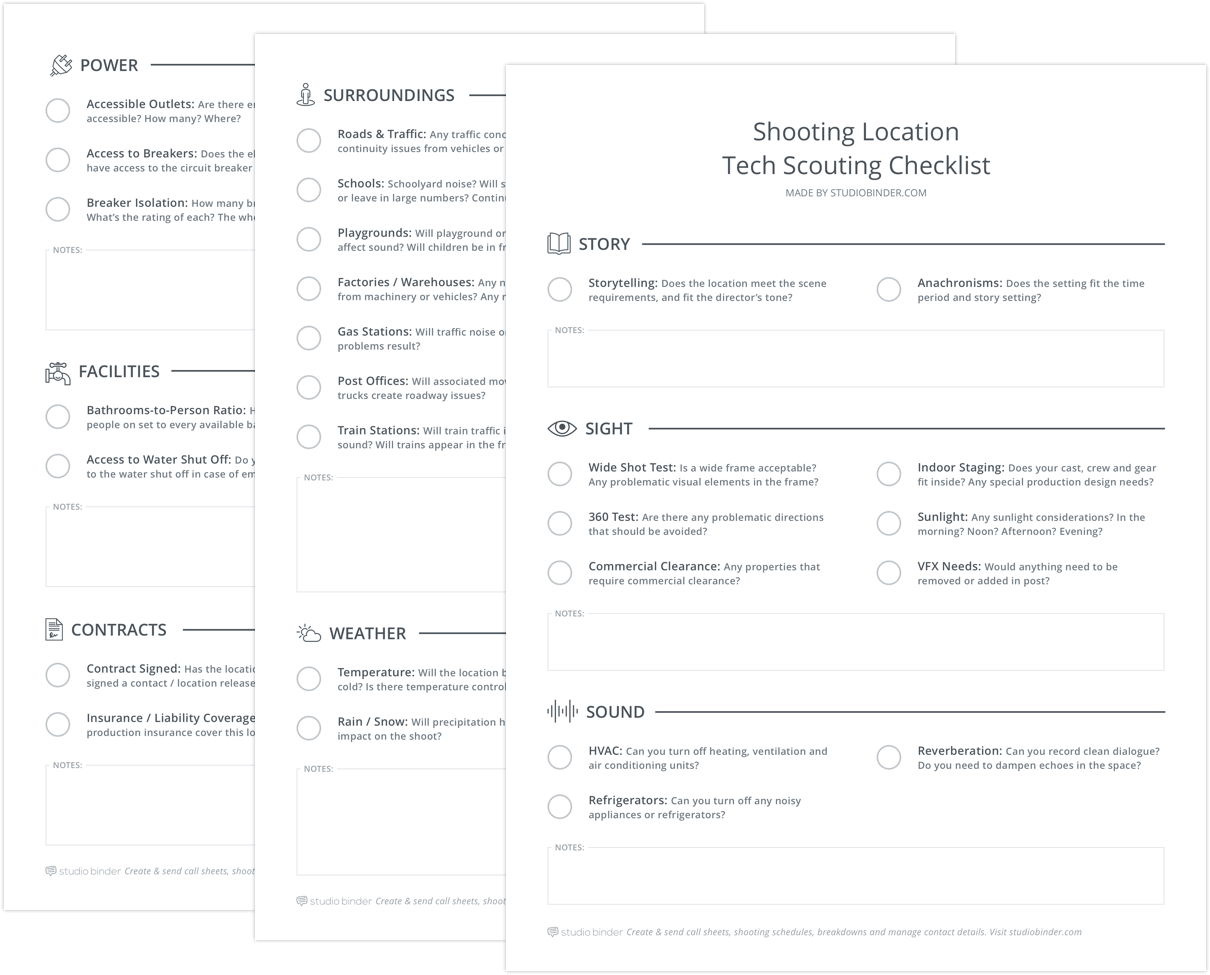
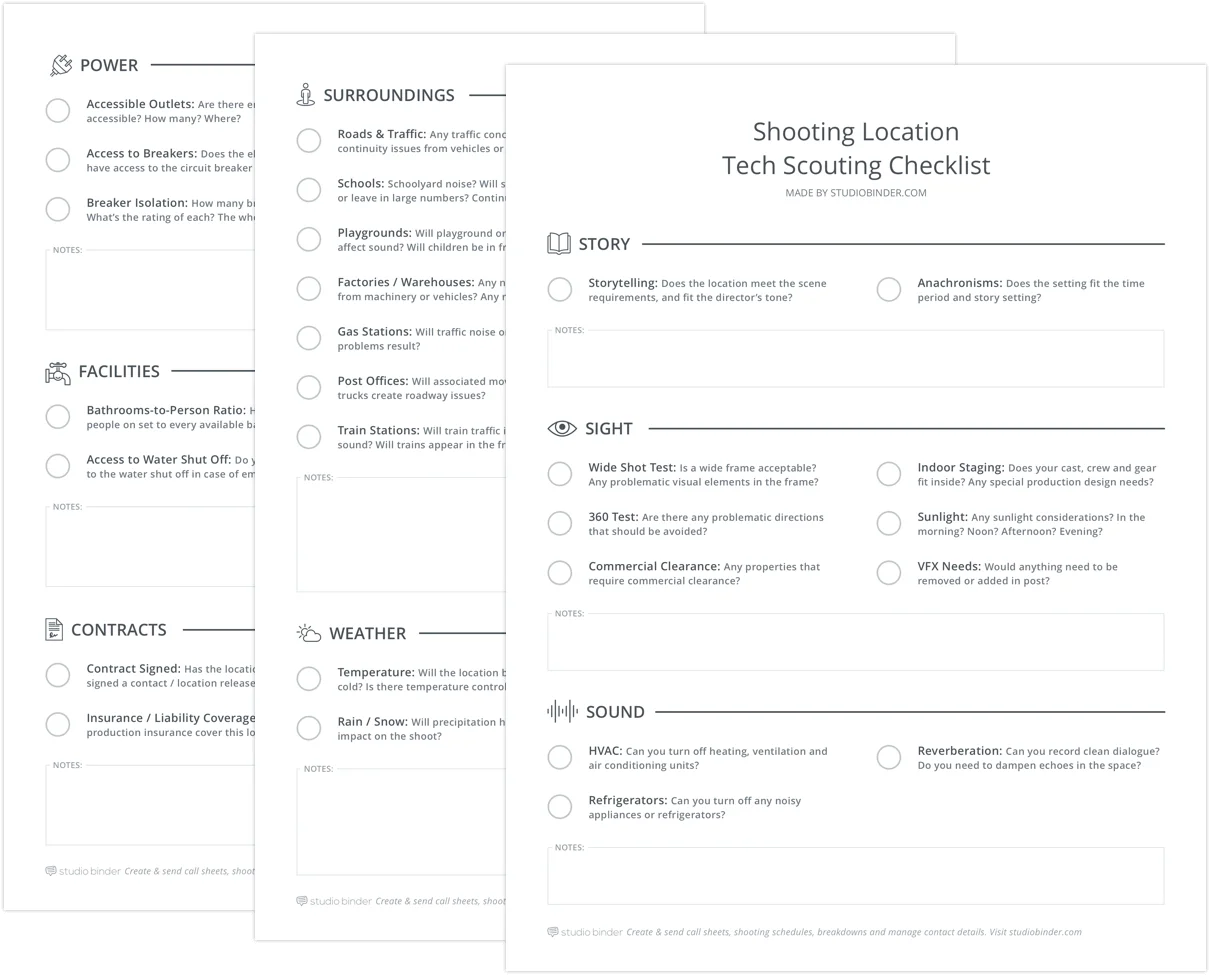

Download your FREE Location Tech Scout checklist.
Just enter your email address and we'll instantly send it to you!
Project management for video creatives. Tasks, file sharing, calendars and more.
Manage video production timelines, tasks, storyboards, shot lists, breakdowns, call sheets. Made for video creatives, new media and film.
